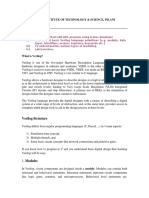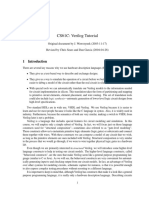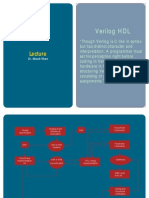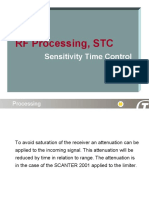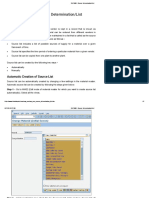VERILOG LAB - CHR
VERILOG LAB - CHR
Uploaded by
David Solomon Raju YellampalliCopyright:
Available Formats
VERILOG LAB - CHR
VERILOG LAB - CHR
Uploaded by
David Solomon Raju YellampalliOriginal Title
Copyright
Available Formats
Share this document
Did you find this document useful?
Is this content inappropriate?
Copyright:
Available Formats
VERILOG LAB - CHR
VERILOG LAB - CHR
Uploaded by
David Solomon Raju YellampalliCopyright:
Available Formats
Simulation Lab Manual 2012-13
Introduction to Verilog
This manual uses short examples to demonstrate the basic Verilog syntax, time delays,
and concurrent execution features. We have tried to condense all the interesting and hard
parts of Verilog into 14 pages and skip all of the boring stuff like what is the difference
between real and integer data types. Studying this document will enable you to model
circuits using simple structural and behavioral Verilog code and provide a solid
framework for learning all the details of the language.
Why Use Verilog
Most Verilog and VHDL books begin with several chapters describing the language's
history and advantages. But the arguments boil down to these:
HDL simulators are better then gate level simulators for 2 reasons: portable
model development, and the ability to design complicated test benches that react
to outputs from the model under test. Finding a model for a unique component for
your particular gate level simulator can be a frustrating task, with an HDL
language you can always write your own model. Also most gate level simulators
are limited to simple waveform based test benches which complicates the testing
of bus and microprocessor interface circuits.
Verilog is a great low level language. Structural models are easy to design and
Behavioral RTL code is pretty good. The syntax is regular and easy to remember.
It is the fastest HDL language to learn and use. However Verilog lacks user
defined data types and lacks the interface-object separation of the VHDL's entity-
architecture model.
VHDL is good for designing behavioral models and incorporates some of the
modern object oriented techniques. It's syntax is strange and irregular, and the
language is difficult to use. Structural models require a lot of code that interferes
with the readability of the model.
C++as an hardware modeling language is excellent choice for high-level
behavioral analysis of a system (like evaluating different data flow architectures
in a microprocessor). However C++ lacks the basic hardware concepts like
knowledge of strengths, connections, and concurrent execution which complicates
model generation for lower level simulations.
Choosing Verilog, VHDL, or C++ will be based on availability of tools, models, and in-
house expertise. If you are just learning your first HDL language we recommend Verilog
because you will be able to quickly become comfortable with the syntax and timing
issues of the language:
Dept of ECE, HITS COE 1
Simulation Lab Manual 2012-13
Verilog Structure
Verilog differs from regular programming languages (C, Pascal ...) in 3 main aspects:
(1) Simulation time concept,
(2) Multiple threads, and
(3) Some basic circuit concepts like network connections and primitive gates.
If you know how to program in C and you understand basic digital design then learning
Verilog will be easy.
Modules
In Verilog, circuit components are designed inside a module. Modules can contain both
structural and behavioral statements. Structural statements represent circuit components
like logic gates, counters, and microprocessors. Behavioral level statements are
programming statements that have no direct mapping to circuit components like loops, if-
then statements, and stimulus vectors which are used to exercise a circuit.
A module starts with the keyword module followed by an optional module name and an
optional port list. The key word endmodule ends a module.
`timescale 1ns / 1ps
//create a NAND gate out of an AND and an Invertor
module some_logic_component (c, a, b);
// declare port signals
output c;
input a, b;
// declare internal wire
wire d;
//instantiate structural logic gates
and a1(d, a, b); //d is output, a and b are inputs
not n1(c, d); //c is output, d is input
endmodule
Structural Design with Gate Primitives and the Delay operator
Verilog defines some basic logic gates as part of the language. The module
some_logic_component instantiates two gate primitives: the not gate and the and gate.
The output of the gate is the first parameter, and the inputs are the rest of the parameters.
Dept of ECE, HITS COE 2
Simulation Lab Manual 2012-13
These primitives are scalable so you can get multiple input gates just by adding inputs
into the parameter list. For example:
nand a1(out1, in1, in2); //2-input NAND gate
nand a2(out1, in1, in2, in3, in4, in5); //5-input NAND gate
notif0 #(10,11,27) inv2(c,d,control) //rise=10, fall=11, off=27(not if
Here is a list of logic primitives defined for Verilog:
Gate Parameter List Examples
scalable, requires at and a1(C,A,B);nand na1(out1,in1,in2,in3,in4);nor
nand nor and least 2 inputs(output, #(5) n1(D,A,B);//delay = 5 time unitsxor #(3,4,5)
or xor xnor input1, input2, … , x1(E,A,B);//rise,fall,off delaysnor #(3:4:5)
inputx) n2(F,A,B);//min:typ:max of delays
not buf (output, input) not inv1(c,a);
control signal active
notif0bufif0 low(output, input, notif0 inv2(c,a, control);
control)
control signal active
notif1bufif1 high(output, input, not inv1(c,a, control);
control)
Structural Design with Assignment Statements
If you have a lot of random logic, the gate primitives of the previous section are tedious
to use because all the internal wires must be declared and hooked up correctly.
Sometimes it is easier to just describe a circuit using a single Boolean equation. In
Verilog, Boolean equations which have similar timing properties as the gate primitives
are defined using a continuous assignment statement.
For example
wire d;
and a1(d, a, b);
not n1(c, d);
can be replaced with one statement:
assign c = !(a && b); //notice that wire d was not used here
Behavioral Design with Initial and Always blocks
Behavioral code is used to describe circuits at a more abstract level then the structural
level statements we have studied. All Behavioral code occurs within either an initial
Dept of ECE, HITS COE 3
Simulation Lab Manual 2012-13
block or in an always block. A module can contain several initial and always blocks.
These behavioral blocks contain statements that control simulation time, data flow
statements (like if-then and case statements), and blocking and non-blocking statements.
An initial block executes once during a simulation. Initial blocks are usually used to
initialize variables and to describe stimulus waveforms which exercise which drive the
simulation.
An always block continuously repeats its execution during a simulation. Always blocks
usually contain behavioral code that models the actual circuit operation.
During a simulation each always and each initial block begin to execute at time zero.
Each block executes concurrently with each structural statement and all the other
behavioral blocks. The following example shows a behavioral SRAM model. The initial
block sets the memory cells to zero at startup. The always block executes each time there
is a change on the write control line, the chip select line, or the address bus. As an
exercise, copy and paste this code into a verilog file and write a test bench to exercise the
model.
//SRAM Model
module sram(CSB,WRB,ABUS,DATABUS);
input CSB; // active low chip select
input WRB; // active low write control
input [11:0] ABUS; // 12-bit address bus
inout [7:0] DATABUS; // 8-bit data bus
//** internal signals
reg [7:0] DATABUS_driver;
wire [7:0] DATABUS = DATABUS_driver;
reg [7:0] ram[0:4095]; // memory cells
integer i;
initial //initialize all RAM cells to 0 at startup
begin
DATABUS_driver = 8'bzzzzzzzz;
for (i=0; i < 4095; i = i + 1)
ram[i] = 0;
end
always @(CSB or WRB or ABUS)
begin
if (CSB == 1'b0)
begin
if (WRB == 1'b0) //Start: latch Data on rising edge of CSB or
WRB
begin
DATABUS_driver <= #10 8'bzzzzzzzz;
@(posedge CSB or posedge WRB);
$display($time," Writing %m ABUS=%b DATA=%b",ABUS,DATABUS);
Dept of ECE, HITS COE 4
Simulation Lab Manual 2012-13
ram[ABUS] = DATABUS;
end
if (WRB == 1'b1) //Reading from sram (data becomes valid after
10ns)
begin
#10 DATABUS_driver = ram[ABUS];
$display($time," Reading %m ABUS=%b DATA=
%b",ABUS,DATABUS_driver);
end
end
else //sram unselected, stop driving bus after 10ns
begin
DATABUS_driver <= #10 8'bzzzzzzzz;
end
end
endmodule
Verilog Syntax Details
Our goal up to this point has been to teach you how to model some simple circuits before
swamping you with all the details about Verilog types, ports, and numbers. But as we do
more Behavioral design it becomes easier to make mistakes in this area.
Structural Data Types: wire and reg
Verilog supports structural data types called nets which model hardware connections
between circuit components. The two most common structural data types are wire and
reg. The wire nets act like real wires in circuits. The reg type hold their values until
another value is put on them, just like a register hardware component. The declarations
for wire and reg signals are inside a module but outside any initial or always block. The
initial state of a reg is x unknown, and the initial state of a wire is z.
Ports:Modules communicate with each other through ports, the signals listed in the
parameter list at the top of the module. Ports can be of type in, out, and inout.
Here are 3 simplistic rules for matching the structural data type to the type of port:
1. Use reg as the outputs of Behavioral blocks. If you us a wire then the value will
never be seen by other blocks.
2. Use wire for all inputs, inouts, and most outputs of Structural elements.
3. If you need a special strength type operation use special net keyword wand, wor,
tir, triand, trior, trireg.
Dept of ECE, HITS COE 5
Simulation Lab Manual 2012-13
Behavioral Data Types: integer, real, and time
The types in integer and real are convenient data types to use for counting in behavioral
code blocks. These data types act like their counter parts in other programming
languages. If you eventually plan to synthesize your behavioral code then you would
probably want to avoid using these data types because they often synthesize large
circuits.
The data type time can hold a special simulator value called simulation time which is
extracted from the system function $time. The time information can be used to help you
debug your simulations.
..... //code fragment from inside a module
integer i, y;
real a;
real b = 3.5;
real c = 4;
time simulationTime;
initial
begin
y = 4;
i = 5 + y;
c = c + 3.5;
a = 5.3e4;
simulationTime = $time;
$display("integer y = %d, i = %f \n", y, i);
$display("reals c = %f, a = %e, b= %g \n", c, a, b);
$display("time simulationTime = %t \n", simulationTime);
end
3.3 Number Syntax
Numbers in verilog are in the following format
The size is always specified as a decimal number. If no is specified then the default size
is at least 32bits and may be larger depending on the machine. Valid base formats are 'b ,
'B , 'h , 'H 'd , 'D , 'o , 'O for binary, hexadecimal, decimal, and octal. Numbers consist
of strings of digits (0-9, A-F, a-f, x, X, z, Z). The X's mean unknown, and the Z's mean
high impedance If no base format is specified the number is assumed to be a decimal
number. Some examples of valid numbers are:
2'b10 // 2 bit binary number
'b10 // at least a 32-bit binary number
3 // at least a 32-bit decimal number
8'hAf // 8-bit hexadecimal
-16'd47 // negative decimal number
Dept of ECE, HITS COE 6
Simulation Lab Manual 2012-13
3.6 Arrays, Vectors, and Memories
Verilog supports three similar data structures called Arrays, Vectors, and Memories.
Arrays are used to hold several objects of the same type. Vectors are used to represent
multi-bit busses. And Memories are arrays of vectors which are accessed similar to
hardware memories. Read the following examples to determine how to reference and use
the different data structures.
//*** Arrays for integer, time, reg, and vectors of reg ***************
integer i[3:0]; //integer array with a length of 4
time x[20:1]; //time array with length of 19
reg r[7:0]; //scalar reg array with length of 8
c = r[3]; //the 3rd reg value in array r is assigned to c
//*** Vectors are multi-bit words of type reg or net (wire)************
reg [7:0] MultiBitWord1; // 8-bit reg vector with MSB=7 LSB=0
wire [0:7] MultiBitWord2; // 8-bit wire vector with MSB=0 LSB=7
reg [3:0] bitslice;
reg a; // single bit vector often referred to as a
scalar
.... //referencing vectors
a = MultiBitWord1[3]; //applies the 3rd bit of MultiBitWord1 to a
bitslice = MultiBitWord1[3:0]; //applies the 3-0 bits of MultiBitWord1
to bitslice
//*** Memories are arrays of vector reg ********************************
reg [7:0] ram[0:4095]; // 4096 memory cells that are 8 bits wide
//code excerpt from Chapter 2 SRAM model
input [11:0] ABUS; // 12-bit address bus to access all 4096 memory
cells
inout [7:0] DATABUS; // 8-bit data bus to wite into and out of a
memory cell
reg [7:0] DATABUS_driver;
wire [7:0] DATABUS = DATABUS_driver; //inout must be driven by a wire
for (i=0; i < 4095; i = i + 1) // Setting individual memory cells to 0
ram[i] = 0;
end
....
ram[ABUS] = DATABUS; //writing to a memory cell
....
DATABUS_driver = ram[ABUS]; //reading from a memory cell
Operators
Here is a small selection of the Verilog Operators which look similar but have different
effects. Logical Operators evaluate to TRUE or FALSE. Bitwise operators act on each bit
of the operands to produce a multi-bit result. Unary Reduction operators perform the
operation on all bits of the operand to produce a single bit result.
Dept of ECE, HITS COE 7
Simulation Lab Manual 2012-13
Operator Name Examples
! logical negation
~ bitwise negation
&& logical and
abus =
& bitwise and
bbus&cbus;
& reduction and abit = &bbus;
~& reduction nand
|| logical or
| bitwise or
| reduction or
~| reduction nor
^ bitwise xor
^ reduction xor
~^ ^~ bitwise xnor
~^ ^~ reduction xnor
logical equality, result may be unknown if x or z in the
== if (a == b)
input
=== logical equality including x and z
logical inequality, result may be unknown if x or z in the
!=
input
!== logical inequality including x and z
> relational greater than
a = shiftvalue
>> shift right by a number of positions
>> 2;
>= relational greater than or equal
< relational less than
<< shift left by a number of positions
<= relational less than or equal if (a <= b)
non blocking assignment statement, schedules
<= assignment for future and allows next statement to #5 b <= b + 2;
execute
blocking assignment statement, waits until assignment
= #5 a = a + 2;
time before allowing next statement to execute
Dept of ECE, HITS COE 8
Simulation Lab Manual 2012-13
How to work with Xilinx
Start ISE from the Start menu by selecting:
Start → All Programs → Xilinx ISE 9.2i → Project Navigator
Create a new project:
1. Select File > New Project... The New Project Wizard appears.
2. Type lab_two in the Project Name field.
3. Leave the local Project Location for this tutorial.
4. Verify that HDL is selected from the Top-Level Source Type list.
5. Click Next to move to the device properties page. (Figure on next page.)
6. Fill in the properties in the table as shown below:
♦ Product Category: All
♦ Family: Spartan3
♦ Device: XC3S200
♦ Package: FT256
♦ Speed Grade: -4
♦ Top-Level Source Type: HDL
♦ Synthesis Tool: XST (VHDL/Verilog)
♦ Simulator: ISE Simulator (VHDL/Verilog)
♦ Preferred Language: Verilog
♦ Verify that Enable Enhanced Design Summary is selected.
Leave the default values in the remaining fields.
7. Click Next to proceed to the Create New Source window in the New Project Wizard.
At the end of the next section, your new project will be complete.
Create the top-level Schematic source file for the project as follows:
1. Click New Source in the New Project dialog box.
2. Select Verilog Module as the source type in the New Source dialog box.
3. Type in the file name counter.
4. Verify that the Add to Project checkbox is selected.
5. Click Next.
6. Declare the ports for the counter design by filling in the port information as shown
below:
Dept of ECE, HITS COE 9
Simulation Lab Manual 2012-13
7. Click Next, then Finish in the New Source Information dialog box to complete the new
source file template.
8. Click Next, then Next, then Finish.
When you choose the “counter.v” tab you will see the outline of a Verilog module.
Notice that it looks somewhat different than the examples in the textbook. Both methods
of listing inputs and outputs are correct!
Now fill in the code for the counter as shown below – you won’t recognize all the
commands but for this tutorial just copy what is shown below.
module counter(CLOCK, DIRECTION, COUNT_OUT);
input CLOCK;
input DIRECTION;
output [3:0] COUNT_OUT;
reg [3:0] count_int = 0;
always @(posedge CLOCK)
if (DIRECTION)
count_int <= count_int + 1;
else
count_int <= count_int - 1;
assign COUNT_OUT = count_int;
endmodule
Dept of ECE, HITS COE 10
Simulation Lab Manual 2012-13
When the source files are complete save the file and check the syntax of the design to
find errors and typos.
1. Verify that Synthesis/Implementation is selected from the drop-down list in the
Sources window.
2. Select the counter design source in the Sources window to display the related
processes in the Processes window.
3. Click the “+” next to the Synthesize-XST process to expand the process group.
4. Double-click the Check Syntax process.
Note: You must correct any errors found in your source files. You can check for errors in
the Console tab of the Transcript window. If you continue without valid syntax, you will
not be able to simulate your design.
Create a test bench waveform containing input stimulus you can use to verify the
functionality of the counter module. The test bench waveform is a graphical view of a test
bench.
Create the test bench waveform as follows:
1. Select the counter HDL file in the Sources window.
2. Create a new test bench source by selecting Project → New Source.
3. In the New Source Wizard, select Test Bench WaveForm as the source type, and type
counter_tbw in the File Name field.
4. Click Next.
5. The Associated Source page shows that you are associating the test bench waveform
with the source file counter. Click Next.
6. The Summary page shows that the source will be added to the project, and it displays
the source directory, type and name. Click Finish.
7. You need to set the clock frequency, setup time and output delay times in the Initialize
Timing dialog box before the test bench waveform editing window opens.
The requirements for this design are the following:
♦ The counter must operate correctly with an input clock frequency = 25 MHz.
♦ The DIRECTION input will be valid 10 ns before the rising edge of CLOCK.
♦ The output (COUNT_OUT) must be valid 10 ns after the rising edge of CLOCK.
The design requirements correspond with the values below.
Fill in the fields in the Initialize Timing dialog box with the following information:
♦ Clock High Time: 20 ns.
♦ Clock Low Time: 20 ns.
♦ Input Setup Time: 10 ns.
♦ Output Valid Delay: 10 ns.
♦ Offset: 0 ns.
♦ Global Signals: GSR (FPGA)
Dept of ECE, HITS COE 11
Simulation Lab Manual 2012-13
Note: When GSR(FPGA) is enabled, 100 ns. is added to the Offset value automatically.
♦ Initial Length of Test Bench: 1500 ns.
Leave the default values in the remaining fields.
8. Click Finish to complete the timing initialization.
9. The blue shaded areas that precede the rising edge of the CLOCK correspond to the
Input Setup Time in the Initialize Timing dialog box. Toggle the DIRECTION port to
define the input stimulus for the counter design as follows:
♦ Click on the blue cell at approximately the 300 ns to assert DIRECTION high so that
the counter will count up.
♦ Click on the blue cell at approximately the 900 ns to assert DIRECTION low so that the
counter will count down.
Dept of ECE, HITS COE 12
Simulation Lab Manual 2012-13
10. Save the waveform.
11. In the Sources window, select the Behavioral Simulation view to see that the test
bench waveform file is automatically added to your project.
Verify that the counter design functions as you expect by performing behavior simulation
as follows:
1. Verify that Behavioral Simulation and counter_tbw are selected in the Sources
window.
2. In the Processes tab, click the “+” to expand the Xilinx ISE Simulator process and
double-click the Simulate Behavioral Model process.
The ISE Simulator opens and runs the simulation to the end of the test bench.
3. To view your simulation results, select the Simulation tab and zoom in on the
transitions.
Note: by selecting COUNT_OUT and right-clicking you can change the hex version to
decimal. You can expand COUNT_OUT to see the individual counter bits.
Dept of ECE, HITS COE 13
Simulation Lab Manual 2012-13
Lab Experiments
1. Implementation of all basic gates
Logic Gate Symbols Truth Tables
Dept of ECE, HITS COE 14
Simulation Lab Manual 2012-13
Verilog Code
Verilog code for AND GATE Verilog code for OR GATE
module and12(a,b,c); module or12(a,b,d);
input a; input a;
input b; input b;
output c; output d;
assign c = a & b; assign d = a | b;
endmodule endmodule
Verilog code for NAND GATE Verilog code for XOR GATE
module nand12(a,b,e); module xor12(a,b,h);
input a; input a;
input b; input b;
output e; output h;
assign e = ~(a & b); assign h = a ^ b;
endmodule endmodule
Verilog code for XNOR GATE Verilog code for NOR GATE
module xnor12(a,b,i); module nor12(a,b,f);
input a; input a;
input b; input b;
output i; output f;
assign i = ~(a ^ b); assign f = ~(a | b);
endmodule endmodule
Verilog code for NOT GATE
module not12(a,g);
input a;
output g;
assign g = ~a;
endmodule
Dept of ECE, HITS COE 15
Simulation Lab Manual 2012-13
2. Implementation of Half adder & Full Adder
A) Half Adder
Truth Table
Input Output
A B S(Sum) C(Carry)
0 0 0 0
0 1 1 0
1 0 1 0
1 1 1 1
Circuit Diagram Graphical Notation
Equations
S (Sum) =A^B
C (Carry) =AB
Verilog code for Half adder
module hadd(a,b,s,c);
input a;
input b;
output s;
output c;
assign s = a ^ b;
assign c = a & b;
endmodule
B)Full Adder
Truth Table
Input Output
A B C SUM Cout
0 0 0 0 0
0 0 1 1 0
0 1 0 1 0
0 1 1 0 1
1 0 0 1 0
1 0 1 0 1
1 1 0 0 1
1 1 1 1 1
K- Map for sum K-map for Carry
Dept of ECE, HITS COE 16
Simulation Lab Manual 2012-13
SUM = A’B’C + A’BC’ + AB’C’ + ABC Cout = A’BC + AB’C + ABC’ +ABC
SUM= A^B^C Cout= (A^B)C+AB
Circuit Diagram
Verilog code for Full adder
module fadd(a,b,c,s,cout);
input a;
input b;
input i;
output s;
output cout;
assign s = (a ^ b) ^ c;
assign cout = (a & b)|( b & c)|(c & a);
endmodule
C) Full Adder Using Two Half Adders and one OR gate
Circuit Diagram
Verilog code for Full adder using half adder
Dept of ECE, HITS COE 17
Simulation Lab Manual 2012-13
module fadd(a,b,ci,s,co);
input a;
input b;
output s;
output cout;
wire c1,c2,s1
HA 1(s1,c1,a,b);
HA 2(s,cout,c1,s1)
endmodule
module HA(s,c,a,b);
input a,b;
output s,c;
s=a^b;
c=ab;
endmodule
Dept of ECE, HITS COE 18
Simulation Lab Manual 2012-13
3 Implementation of 1:4 and 4:1 Multiplexer
A) 4:1 Multiplexer
Function Table
Selection output
Inputs
S1 S0
0 0 D0
0 1 D1
1 0 D2
1 1 D3
Block Diagram 4:1 Multiplexer
Circuit Diagram 4:1 Multiplexer
Dept of ECE, HITS COE 19
Simulation Lab Manual 2012-13
Verilog code 4 to 1 for multiplexer
module mux4to1(Y, I0,I1,I2,I3, sel);
output Y;
input I0,I1,I2,I3;
input [1:0] sel;
reg Y;
always @ (sel or I0 or I1 or I2 or I3)
case (sel)
2'b00:Y=I0;
2'b01:Y=I1;
2'b10: Y=I2;
2'b11: Y=I3;
default: Y=2b’00;
endcase
endmodule
B)1:4 Demultiplexer
Function table
Data Selection Output
Input Input
D S1 S0 Y3 Y2 Y1 Y0
1 0 0 0 0 0 1
1 0 1 0 0 1 0
1 1 0 0 1 0 0
1 1 1 1 0 0 0
Function Table
Inputs Output
S1 S0
0 0 Y0=D
0 1 Y1=D
1 0 Y2=D
1 1 Y3=D
Block Diagram 1:4 Demultiplexer
Dept of ECE, HITS COE 20
Simulation Lab Manual 2012-13
Circuit Diagram 1:4 Demultiplexer
Verilog code for 1 to 4 demultiplexer
module demux(S,D,Y);
Input [1:0] S;
Input D;
Output [3:0] Y;
reg Y;
always @(S OR D)
case({D,S})
3’b100:Y=4’b0001;
3’b101:Y=4’b0010;
3’b110:Y=4’b0100;
3’b111:Y=4’b1000;
default:Y=4’b0000;
endcase
endmodule
Dept of ECE, HITS COE 21
Simulation Lab Manual 2012-13
4. Implementation of encoder (with and without priority) and Decoder
A) 3-8 line Decoder
Function Table
Input Output
enable A1 A1 A0 Z7 Z6 Z5 Z4 Z3 Z2 Z1 Z0
0 x x x 0 0 0 0 0 0 0 0
1 0 0 0 0 0 0 0 0 0 0 1
1 0 0 1 0 0 0 0 0 0 1 0
1 0 1 0 0 0 0 0 0 1 0 0
1 0 1 1 0 0 0 0 1 0 0 0
1 1 0 0 0 0 0 1 0 0 0 0
1 1 0 1 0 0 1 0 0 0 0 0
1 1 1 0 0 1 0 0 0 0 0 0
1 1 1 1 1 0 0 0 0 0 0 0
Block Diagram 3-8 line Decoder
Z7
A0
Z6
A1
A2 Z5
Z4
3 to 8 line Z3
decoder Z2
Z1
Enable Z0
Circuit Diagram 3-8 line Decoder
Dept of ECE, HITS COE 22
Simulation Lab Manual 2012-13
Verilog Code for 3 to 8 line decoder
Module dec(bin,decout,en);
input [0:2] bin;
input en;
output [7:0] decout;
reg decout;
always @(en or bin)
begin
decout=0;
if(en)
begin
case(bin)
3’b000:decout=8’o001;
3’b001:decout=8’o002;
3’b010:decout=8’o004;
3’b011:decout=8’o010;
3’b100:decout=8’o020;
3’b101:decout=8’o040;
3’b110:decout=8’o100;
3’b111:decout=8’o200;
endcase
end
end
endmodule
B) 8:3 line encode(Octal-Binary Conversion)
Function Table
Input
enable I7 I6 I5 I4 I3 I2 I1 I0 Y2 Y1 Y0
0 x x x x x x x x 0 0 0
1 0 0 0 0 0 0 0 1 0 0 0
1 0 0 0 0 0 0 1 0 0 0 1
1 0 0 0 0 0 1 0 0 0 1 0
1 0 0 0 0 1 0 0 0 0 1 1
1 0 0 0 1 0 0 0 0 1 0 0
1 0 0 1 0 0 0 0 0 1 0 1
1 0 1 0 0 0 0 0 0 1 1 0
1 1 0 0 0 0 0 0 0 1 1 1
Y0 = I1 + I3 + I5 + I7
Y1= I2 + I3 + I6 + I7
Y2 = I4 + I5 + I6 +I7
Block Diagram8:3 line encoder(Octal-Binary Conversion)
Z7
A0
Z6
Z5 A1
Z4
Z3 8 to 3 line A2
Z2 decoder
Z1
Z0
Dept of ECE, HITS COE 23
Enable
Simulation Lab Manual 2012-13
Circuit Diagram8:3 line encoder (Octal-Binary Conversion)
Verilog Code for Encoder
module encodeR(I0,I1,I2,I3,Y0,Y1,Y3);
input I0,I1,I2,I3;
output Y0,Y1,Y3;
wire Y0,Y1,Y3;
Y0 = I1 | I3 | I5| I7
Y1= I2 |I3 | I6 | I7
Y2 = I4 | I5 | I6 |I7
Endmodule
C) Priority Encoder
Function Table
K-Map simplification
Dept of ECE, HITS COE 24
Simulation Lab Manual 2012-13
Y0=D3+D1D’2
Y1=D2+D3
V=D0+D1+D2+D3
Circuit Diagram
Verilog Code priority encoder
module encodeR(D0,D1,D2,D3,Y0,Y1,V3);
input I0,I1,I2,I3;
output Y0,Y1,Y3;
wire Y0,Y1,V;
Y0=D3|D1|~D2
Y1=D2|D3
V=D0|D1|D2|D3
endmodule
Dept of ECE, HITS COE 25
Simulation Lab Manual 2012-13
5 Implementation of BCD Adder Truth Table
Binary Sum BCD Sum Decimal
K Z8 Z4 Z2 Z1 C S8 S4 S2 S1
0 0 0 0 0 0 0 0 0 0 0
0 0 0 0 1 0 0 0 0 1 1
0 0 0 1 0 0 0 0 1 0 2
0 0 0 1 1 0 0 0 1 1 3
0 0 1 0 0 0 0 1 0 0 4
0 0 1 0 1 0 0 1 0 1 5
0 0 1 1 0 0 0 1 1 0 6
0 0 1 1 1 0 0 1 1 1 7
0 1 0 0 0 0 1 0 0 0 8
0 1 0 0 1 0 1 0 0 1 9
0 1 0 1 0 1 0 0 0 0 10
0 1 0 1 1 1 0 0 0 1 11
0 1 1 0 0 1 0 0 1 0 12
0 1 1 0 1 1 0 0 1 1 13
0 1 1 1 0 1 0 1 0 0 14
0 1 1 1 1 1 0 1 0 1 15
1 0 0 0 0 1 0 1 1 0 16
1 0 0 0 1 1 0 1 1 1 17
1 0 0 1 0 1 1 0 0 0 18
1 0 0 1 1 1 1 0 0 1 19
Circuit
Diagram
C= K+ Z1Z3+ Z2Z3
Dept of ECE, HITS COE 26
Simulation Lab Manual 2012-13
Verilog Code for BCD adder
module bcd_adder(sum,output_carry,addend,augend,carry_in);
output [3:0] sum;
output output_carry;
input [3:0] addend;
input [3:0] augend;
input carry_in;
wire [3:0] z_addend;
wire carry_out;
wire c_out;
wire [3:0] z_sum;
adder_4bit m0(carry_out,z_sum,addend,augend,carry_in);
and (w1,z_sum[3],z_sum[2]);
and (w2,z_sum[3],z_sum[1]);
assign z_addend={1’b0,output_carry,output_carry,1’b0);
or(output_carry,carry_out,w1,w2);
adder_4bit(c_out,sum,z_addend,z_sum,1’b0);
or(c_out,carry_out,c_out);
endmodule
module adder_4bit(carry,sum,a,b,cin);
output carry;
input [3:0] sum;
input [3:0] a,b;
input c_in;
assign {carry,sum}=a+b+cin;
endmodule
Dept of ECE, HITS COE 27
Simulation Lab Manual 2012-13
6 Implementation of 4-bit Magnitude Comparator
Consider two 4-bit binary numbers A and B such that
A = A3A2A1A0
B = B3B2B1B0
(A = B) = x3x2x1x0
Circuit Diagram
Verilog code(Abstract level)
module compare(A,B,y);
input [3:0] A,B;
output [2:0] y;
reg y;
always @(A or B)
if(A==B)
y=3’b001;
else if(A<B)
y=3’b010;
else
y=3’b100;
endmodule
Dept of ECE, HITS COE 28
Simulation Lab Manual 2012-13
Verilog code for 4-bit magnitude comparator
module compare(A,B,x,y,z);
input [3:0] A,B;
output x, y,z;
wire x0,x1,x2,x3;
assign x0=((~A[0]&B[0])| (A[0]&~B[0]));
assign x1=((~A[1]&B[1])| (A[1]&~B[1]));
assign x2=((~A[2]&B[2])| (A[2]&~B[2]));
assign x3=((~A[3]&B[3])| (A[3]&~B[3]));
assign x=x0&x1&x2&x3;
assign y=((A[3]&~B[3]|(x3&A[2]&~B[2])|(x3&x2&A[1]&~B[1])|(x3&x2&x1&A[0]&~B[0]));
assign z=((~A[3]&B[3]|(x3&~A[2]&B[2])|(x3&x2&~A[1]&B[1])|(x3&x2&x1&~A[0]&B[0]));
endmodule
Dept of ECE, HITS COE 29
Simulation Lab Manual 2012-13
7. Implementation of Flip flops [JK, D and T].
A) JK Flip-Flop
Circuit Diagram
Graphical Notation
Characteristic Table
Input Input Output
J K CP Q(t+1)
x x 0 No
Change
0 0 Q(t)
0 1 0
1 0 1
1 1 Q’(t)
Characteristic Equation
Q(t+1)=JQ’(t)+K’Q(t)
Verilog code for JK flip flop
module jkff(jk,pst,clr,clk,qp,qbar);
input [1:0] jk; input pst,clr,clk;
output qp,qbar;
reg qp; wire q;
always @ (posedge clk)
if (pst)
qp= 1;
else
begin
if (clr)
qp= 0;
else
begin
case (jk)
2'b00: qp=q;
Dept of ECE, HITS COE 30
Simulation Lab Manual 2012-13
2'b01 : qp = 1'b0;
2'b10 : qp =1'b1;
2'b11 : qp = ~q;
default qp =0;
endcase
end
end
assign qbar = ~q;
assign q = qp;
endmodule
B)D-Flip Flop
Circuit Diagram
Graphical Notation
Characteristic Table
Input Clock Input Next
State
D CP Q(t+1)
x 0/1 No
Change
0 0
1 1
Characteristic Equation
Q(t+1)=D
Verilog code for D flip flop:
module dff(d,clk,q,qbar);
input d;
input clk;
output q,qbar;
reg q, qbar;
always @ (posedge clk)
begin
q = d;
qbar = ~d;
end
Dept of ECE, HITS COE 31
Simulation Lab Manual 2012-13
endmodule
C) T-Flip Flop
Circuit Diagram
Graphical Notation
Characteristic Table
Input Clock Input Next
State
T CP Q(t+1)
x 0/1 No
Change
0 Q(t)
1 Q’(t)
Characteristic Equation
Q (t+1)=T’Q(t)+TQ’(t)
Verilog code for T flip flop:
module tffeq(t,rst, clk,qp, qbar);
input t,rst, clk;
output qp, qbar;
wire q;
reg qp;
always @ (posedge clk)
if (rst)
qp=0;
else
qp = q ^ t;
assign qbar = ~ qp;
endmodule
Dept of ECE, HITS COE 32
Simulation Lab Manual 2012-13
8 Implementation of counters [Ripple, up down].
A) 4-Bit Binary Ripple Counter
Function Table
Output(count 0-15)
A B C D
0 0 0 0
0 0 0 1
0 0 1 0
0 0 1 1
0 1 0 0
0 1 0 1
0 1 1 0
0 1 1 1
1 0 0 0
1 0 0 1
1 0 1 0
1 0 1 1
1 1 0 0
1 1 0 1
1 1 1 0
1 1 1 1
Circuit Diagram
Verilog Code for Ripple Counter
module ripple(clkr,st,,t,A,B,C,D);
input clk,rst,t;
output A,B,C,D;
Tff T0(D,clk,rst,t);
Tff T1(C,clk,rst,t);
Tff T2(B,clk,rst,t);
Tff T3(A,clk,rst,t);
endmodule
module Tff(q,clk,rst,t);
input clk,rst,t;
output q;
reg q;
always @(posedge clk)
begin
if(rst)
q<=1’b0;
else
if(t)
Dept of ECE, HITS COE 33
Simulation Lab Manual 2012-13
q<=~q;
end
endmodule
B)4-bit Up-Down Counter
Count Table
Output(count Output (count up)
down)
Q0 Q1 Q2 Q3 Q1 Q2 Q3
Q0
1 1 1 1 0 0 0 0
1 1 1 0 0 0 0 1
1 1 0 1 0 0 1 0
1 1 0 0 0 0 1 1
1 0 1 1 0 1 0 0
1 0 1 0 0 1 0 1
1 0 0 1 0 1 1 0
1 0 0 0 0 1 1 1
0 1 1 1 1 0 0 0
0 1 1 0 1 0 0 1
0 1 0 1 1 0 1 0
0 1 0 0 1 0 1 1
0 0 1 1 1 1 0 0
0 0 1 0 1 1 0 1
0 0 0 1 1 1 1 0
0 0 0 0 1 1 1 1
Circuit diagram
Dept of ECE, HITS COE 34
Simulation Lab Manual 2012-13
Verilog code for up-down counter
module updowncount (R, Clock, clr, E, up_down, Q);
parameter n = 4;
input [n-1:0] R;
input Clock, clr, E, up_down;
output [n-1:0] Q;
reg [n-1:0] Q;
integer direction;
always @(posedge Clock)
begin
if (up_down) direction = 1;
else direction = -1;
if (clr) Q <= R;
else if (E) Q <= Q + direction;
end
endmodule
Dept of ECE, HITS COE 35
Simulation Lab Manual 2012-13
9) Implementation of counters [Ring, Johnson].
A) Ring Counter
Circuit Diagram for ring counter
Count Table
clk Qa Qb Qc Qd
1 1 0 0 0
2 0 1 0 0
3 0 0 1 0
4 0 0 0 1
Verilog code for ring counter
module ring_count (Resetn, Clock, Q);
parameter n = 5;
input Resetn, Clock;
output [n-1:0] Q;
reg [n-1:0] Q;
always @(posedge Clock)
Dept of ECE, HITS COE 36
Simulation Lab Manual 2012-13
if (!Resetn)
begin
Q[4:1] <= 0;
Q[0] <= 1;
end
else
Q <= {{Q[3:0]}, {Q[4]}};
endmodule
B) Johnson Counter
Circuit Diagram for Johnson counter
outputs
Vcc QA QB QC QD CLK1
14 13 12 11 10 9 8
74LS95
1 2 3 4 5 6 7
A B C D
A1A
2 1
Count Table
Verilog code
Dept of ECE, HITS COE 37
Simulation Lab Manual 2012-13
module stc(clk,clr,q,r,s,t);
input clk,clr;
output q,r,s,t;
reg q,r,s,t;
always@(negedge clk)
begin
if(~clr)
begin
q=1'b0;
end
else
begin
q<=~t;
r<=q;
s<=r;
t<=s;
end
end
endmodule
Dept of ECE, HITS COE 38
Simulation Lab Manual 2012-13
10 Implementation of 4- bit serial adder
Circuit Diagram for 4-bit serial adder
Verilog Code for serial adder
module serial_adder(a,c,clk,rst,pl,si,sr,qout,p0);
input clk,rst,si,sr,pl;
output qout;
output [3:0] p0;
reg [3:0] sra;
reg [3:0] srb;
input [3:0] a;
input [3:0] b;
reg p0;
wire s,c;
FA f1(sra[0].srb[0],qout,s,c);
always @ (posedge clk)
begin
if(rst)
begin
sra=4’b0000;
srb=4’b0000;
qout=0;
p0=4’b0000;
end
else if(pl)
begin
sra=a;
Dept of ECE, HITS COE 39
Simulation Lab Manual 2012-13
srb=b;
end
else if(sr)
begin
sra={s,sra[3:1]};
srb={si,srb[3:1]};
qout=c;
end;
else
qout=qout;
p0=sra;
end
endmodule
Full adder module
module FA(a,b,c,s,c);
input a,b,c;
output s,c;
assign s=a^b^c;
assign c=((a^b)&c)|(a&b);
endmodule
Dept of ECE, HITS COE 40
Simulation Lab Manual 2012-13
11 Implementation of universal shift register
Circuit Diagram for universal shift register
Function Diagram
Notes
H = HIGH voltage level
h = HIGH voltage level one set-up time prior to the LOW-to-HIGH CP transition
L = LOW voltage level
Dept of ECE, HITS COE 41
Simulation Lab Manual 2012-13
I = LOW voltage level one set-up time prior to the LOW-to-HIGH CP transition
q,d = lower case letters indicate the state of the referenced input (or output) one set-up
time prior to the
LOW-to-HIGH CP transition
X = don’t care
= LOW-to-HIGH CP transition
Verilog Code
module uni_shift(out,l0,r0,in,li,ri,s,clr,clk);
output [3:0] out;
output l0,r0;
input [3:0] in;
intput [1:0] s;
input li,ri,clr,clk;
reg out;
assign l0=out[3];
assign r0=out[0];
always @ (posedge clk)
begin
if(clr)
out<=0;
else
case(s)
3:out<=in;
2:out<={out[2:0],ri};
1:out<={li,out[3:1]};
0:out<=out;
endcase
end
endmodule
Dept of ECE, HITS COE 42
Simulation Lab Manual 2012-13
12. Implementation of Sequential Binary Multiplier.
Inputs: A: First 4-Bit operand (multiplier). B: Second 4-Bit operand (multiplicand). S: Start
signal which initiates the multiplication operation Reset: Reset signal which puts the controller
into the initial state.
Outputs: P: The 8-bit product result (P = A x B).
Block Diagram
Binary Multiplication
Multiplier Data Path
The data path for the sequential multiplier is consists of several registers and an adder.
The required registers include:
Dept of ECE, HITS COE 43
Simulation Lab Manual 2012-13
B-Register: A 4-bit register which holds the multiplicand (B)
P-Register: An 8-bit register which consists of two 4-bit registers PL (P-Low) and
PH (P-High).
Initially the multiplier (A) is loaded in PL, while PH is cleared
The final result (product) is stored in P = (PH, PL).
E-Register: A 1-bit register, that is used to hold the carryout output of the adder
Initially E is cleared th
It may be considered the 9 Bit of P, i.e. P8.
In the final step, E will hold a 0 value.
Cnt: A 2-bit down counter used to control the number of steps to be performed (total of 4
steps). The counter counts from 3 down to 0. The operation is stopped when the count
reaches 0. This zero condition (Zero) is detected by a NOR gate
Notation: (E, PH) refers to the 5-bit register consisting of E as the MSB and PH. (E,
PH, PL) refer to the 9-bit register consisting of E as the MSB, PH. and PL.
Computation Steps:
1. Initialize: i=0, PH? 0, PL? A, B-Reg? B, Cnt? n-1, where n = number of
operand bits.
2. (E, PH)? PH + aiB = PH + P0B;
3. Shift (E, PH, PL) right by one bit; Cnt? Cnt -1; and i=i+1.
4. IF Cnt = 0 then STOP else Loop back to step 2
Example: A=1011, B=1101, then n = 4.
1. Initialization: P = (PH, PL) = 0000_1011 B = 1101 Cnt = 3 i = 0
2. E, PH? PH + P0B = (0000) + (1101) = 01101 (E, PH, PL) = (0, 1101, 1011)
3. Shift P Right –-- P = (0110, 1101), Cnt = 2, and i=1
Dept of ECE, HITS COE 44
Simulation Lab Manual 2012-13
4. E, PH? PH + P0B = (0110) + (1101) = 10011 (E, PH, PL) = (1, 0011, 1101)
5. Shift P Right –-- P = (1001, 1110), Cnt = 1, and i=2
6. E, PH? PH + P0B = (1001) + (0000) = 01001 (E, PH, PL) = (0, 1001, 1110)
7. Shift P Right –-- P = (0100, 1111) , Cnt = 0, and i=3 (Note that Cnt becomes 0
only after the next clock not while being in state S2)
8. E, PH? PH + P0B = (0100) + (1101) = 10001 (E, PH, PL) = (1, 0001, 1111)
9. Shift P Right –-- P = (1000, 1111) , Cnt = 0
10. STOP.
Verilog code
module mult(product,ready,multiplicand,multiplier,start,clock,reset_b);
parameter dp_width=5;
output [2*dp_width-1:0] product;
output ready;
input [dp_width-1:0] multiplicand,multiplier;
input start, clock,reset_b;
parameter bc_size=3;
parameter s_Idle=3'b001;
parameter s_add=3'b010;
parameter s_shift=3'b100;
reg [2:0] state,next_state;
reg [dp_width-1:0] A,B,Q;
reg c;
reg [bc_size-1:0] p;
reg load_regs,dec_p,add_regs,shift_regs;
// miscellaneous combinational logic
assign product={A,B};
wire zero=(p==0);
//zero=~p;
wire ready=(state==s_idle);
// control unit
always @ (posedge clock, negedge reset_b)
if(~reset_b)
state<=s_idle;
else
state<=next_state;
always @ (state,start,Q[0],zero)
begin
next_state=s_idle;
load_regs=0;
decr_p=0;
add_regs=0;
shift_regs=0;
case(state)
s_idle:begin
If(start)
Next_state=s_add;
Dept of ECE, HITS COE 45
Simulation Lab Manual 2012-13
load_regs=1;
end
s_add: begin
next_state=s_shift;
decr_p=1;
if(Q[0])
add_regs=1;
end
s_shift:begin
shift_regs=1;
if(zero)
next_state=s_idle;
else
next_stae=s_add;
end
default: next_state=s_idle;
endcase
// data unit
always @(posedge clock)
begin
if(load_regs)
begin
p<=dp_width;
A<=0;
C<=0;
B<=multiplicand;
Q<=multiplier;
end
if(add_regs)
{C,A}=A+B;
If(shift_regs}
{C,A,Q}<={C,A,Q}>>1;
If(decr_p)
p<=p-1;
end
endmodule
A. Introduction to Xilinx Software
Software’s used are:
*Xilinx 9.2i for Simulation and Synthesis
*Model sim for Simulation
Dept of ECE, HITS COE 46
Simulation Lab Manual 2012-13
Loading the Projects:
To load the project first we need to double click the Xilinx 9.2i ISE shortcut present on
the desktop or in corresponding drive. As soon as the software opens it shows a ‘Tip of
the day’ on which we select ok.
To load new project selesct File new project
Dept of ECE, HITS COE 47
Simulation Lab Manual 2012-13
Now enter the project name then click next.
Dept of ECE, HITS COE 48
Simulation Lab Manual 2012-13
Make appropriate selections and click next then Add source using Add source option and
click to load files.
Click ok then finish to load the project
Dept of ECE, HITS COE 49
Simulation Lab Manual 2012-13
To synthesize check syntax first in the behavioral simulation mode and simulate using
simulate behavioral mode.
The simulation is then executed and output schematic is shown.
Dept of ECE, HITS COE 50
You might also like
- QAM Chapter09 Transportation Assignment and Network ModelsDocument61 pagesQAM Chapter09 Transportation Assignment and Network ModelsdavidpamanNo ratings yet
- VHDL Interview Question(s)Document8 pagesVHDL Interview Question(s)Sudheer AcharyaNo ratings yet
- Interview Questions for IBM Mainframe DevelopersFrom EverandInterview Questions for IBM Mainframe DevelopersRating: 1 out of 5 stars1/5 (1)
- Assignment & Quiz (Matlab)Document24 pagesAssignment & Quiz (Matlab)David Solomon Raju Yellampalli100% (1)
- Digital Design Lab Manual: Introduction To VerilogDocument48 pagesDigital Design Lab Manual: Introduction To VerilogKeith FernandesNo ratings yet
- Chapter1: Introduction To VerilogDocument15 pagesChapter1: Introduction To Verilogarunguptha_gsNo ratings yet
- VlogDocument14 pagesVlogUday KumarNo ratings yet
- Verilog For PrintDocument15 pagesVerilog For PrintrppvchNo ratings yet
- Verilog TutDocument21 pagesVerilog TutNishana KumarNo ratings yet
- Birla Institute of Technology & Science, Pilani Lab Sheet - 1Document7 pagesBirla Institute of Technology & Science, Pilani Lab Sheet - 1SATYAVRAT SHARMANo ratings yet
- 2) Difference Between Blocking and Non-Blocking? (Verilog Interview Questions That Is MostDocument39 pages2) Difference Between Blocking and Non-Blocking? (Verilog Interview Questions That Is MostRAGUL RAJ SNo ratings yet
- Drill 1 Part 1 Rev1Document10 pagesDrill 1 Part 1 Rev1kage mushaNo ratings yet
- Lab # 2 Verilog Structure: 2.1 ModulesDocument5 pagesLab # 2 Verilog Structure: 2.1 ModulesThe Common YoutuberNo ratings yet
- Drill 1Document10 pagesDrill 1kage mushaNo ratings yet
- Assign VerilogDocument4 pagesAssign Verilogafefhrbdf100% (1)
- Verilog HDLDocument62 pagesVerilog HDLc406400100% (1)
- Vls I Lab Manual 2021Document58 pagesVls I Lab Manual 2021shilpakesavNo ratings yet
- Day1 and 2Document48 pagesDay1 and 2Effecure HealthcareNo ratings yet
- The Verilog LanguageDocument83 pagesThe Verilog LanguageHimanshu GuptaNo ratings yet
- Lecture2 CuongDocument51 pagesLecture2 Cuongsongoku711No ratings yet
- DRILL1Document9 pagesDRILL1Paterson SoroñoNo ratings yet
- VerilogDocument115 pagesVeriloganurag kumarNo ratings yet
- Verilog Lecture 1 - NoopurDocument41 pagesVerilog Lecture 1 - NoopurMonis KhanNo ratings yet
- DSD ReportDocument14 pagesDSD Report22051774No ratings yet
- VerilogDocument80 pagesVeriloggenx142No ratings yet
- HDLDocument141 pagesHDLsauryan123No ratings yet
- Verilog AssignDocument8 pagesVerilog Assignafodcwdycgpena100% (1)
- EE-421 Digital System Design Lab (Fall 2016) : Or, NotDocument12 pagesEE-421 Digital System Design Lab (Fall 2016) : Or, NotBilal SiddiqueNo ratings yet
- Verilog GATE AND DATA FLOWDocument64 pagesVerilog GATE AND DATA FLOWPRIYA MISHRANo ratings yet
- WINSEM2024-25_BECE102P_LO_VL2024250504270_2024-12-14_Reference-Material-IIDocument23 pagesWINSEM2024-25_BECE102P_LO_VL2024250504270_2024-12-14_Reference-Material-IIanshahlawat555No ratings yet
- Verilog BriefDocument12 pagesVerilog BriefShashin KunasegaranNo ratings yet
- Ver I Log TutorialDocument18 pagesVer I Log Tutorialritam yadavNo ratings yet
- Verilog HDL: Dr. Shoab KhanDocument61 pagesVerilog HDL: Dr. Shoab KhanSufyan AsgharNo ratings yet
- Verilog Interview QuestionsDocument39 pagesVerilog Interview Questionskvxrw7201No ratings yet
- Verilog HDL BasicsDocument73 pagesVerilog HDL BasicsSyed AshmadNo ratings yet
- DD&CO Full Lab ManualDocument45 pagesDD&CO Full Lab ManualHarshitha SinghNo ratings yet
- You Could Download File D - FF.VDocument133 pagesYou Could Download File D - FF.VPradeep BabuNo ratings yet
- VLSI Design - VerilogDocument30 pagesVLSI Design - Veriloganand_duraiswamyNo ratings yet
- Hardware Description Language: B. RamamurthyDocument19 pagesHardware Description Language: B. Ramamurthysoumya vollalaNo ratings yet
- System Verilog IntroductionDocument20 pagesSystem Verilog IntroductionRamakrishnaRao SoogooriNo ratings yet
- Verilog FAQ TIDBITSDocument31 pagesVerilog FAQ TIDBITSrAM100% (4)
- Basic Logic Design With Verilog HDL:: Gate-Level Design On Combinational CircuitsDocument101 pagesBasic Logic Design With Verilog HDL:: Gate-Level Design On Combinational Circuitsvenky_ladNo ratings yet
- Verilog HDLDocument180 pagesVerilog HDLrabiatul adawiyahNo ratings yet
- Intro HDLDocument141 pagesIntro HDLAnonymous IN80L4rRNo ratings yet
- Vlsi Unit 5 NotesDocument21 pagesVlsi Unit 5 NotesRamana Sekar100% (1)
- LAB#1Document5 pagesLAB#1Usama BalochNo ratings yet
- Verilog-2001, System Verilog and Verilog-Ams: Presentation OnDocument19 pagesVerilog-2001, System Verilog and Verilog-Ams: Presentation Onsathi_toyaNo ratings yet
- VerilogDocument29 pagesVerilogUmamahesh MavuluriNo ratings yet
- Chapter10 VerilogDocument62 pagesChapter10 VerilogdilipbagadiNo ratings yet
- Lab No: 1 Introduction To Verilog (Gate-Level Modeling, Data-Flow Modeling and Behavioral Modeling)Document3 pagesLab No: 1 Introduction To Verilog (Gate-Level Modeling, Data-Flow Modeling and Behavioral Modeling)MaleehaBabarNo ratings yet
- Verilog Interview Questions & AnswersDocument6 pagesVerilog Interview Questions & AnswersKrishna Saroja SankaNo ratings yet
- DVCon Europe 2015 TA5 1 PaperDocument7 pagesDVCon Europe 2015 TA5 1 PaperJon DCNo ratings yet
- VerilogTutorial 2Document80 pagesVerilogTutorial 2Manjinder Singh BaathNo ratings yet
- EE344 - Digital Systems DesginDocument27 pagesEE344 - Digital Systems Desgin0307aliNo ratings yet
- FPGA ExperimentsDocument4 pagesFPGA Experimentsjosenit1787No ratings yet
- Vlsi Manual 2013-2014Document36 pagesVlsi Manual 2013-2014hr_suresh_kNo ratings yet
- INTERVIEW QUESTIONS - Verilog - PART-1Document9 pagesINTERVIEW QUESTIONS - Verilog - PART-1charan tejaNo ratings yet
- Projects With Microcontrollers And PICCFrom EverandProjects With Microcontrollers And PICCRating: 5 out of 5 stars5/5 (1)
- Practical Reverse Engineering: x86, x64, ARM, Windows Kernel, Reversing Tools, and ObfuscationFrom EverandPractical Reverse Engineering: x86, x64, ARM, Windows Kernel, Reversing Tools, and ObfuscationNo ratings yet
- ORACLE PL/SQL Interview Questions You'll Most Likely Be AskedFrom EverandORACLE PL/SQL Interview Questions You'll Most Likely Be AskedRating: 5 out of 5 stars5/5 (1)
- 1.wein Bridge Oscillator (Model:EDC-12)Document2 pages1.wein Bridge Oscillator (Model:EDC-12)David Solomon Raju YellampalliNo ratings yet
- Bapatla Women'S Engineering CollegeDocument78 pagesBapatla Women'S Engineering CollegeDavid Solomon Raju YellampalliNo ratings yet
- Bapatla Women'S Engineerig College Page1Document8 pagesBapatla Women'S Engineerig College Page1David Solomon Raju YellampalliNo ratings yet
- International Series: Global Perspectives On Education in COVID-19 Times: Challenges & OpportunitiesDocument3 pagesInternational Series: Global Perspectives On Education in COVID-19 Times: Challenges & OpportunitiesDavid Solomon Raju YellampalliNo ratings yet
- Yogi Vemana University: Ph.D. Programs Academic Year 2021-2022Document4 pagesYogi Vemana University: Ph.D. Programs Academic Year 2021-2022David Solomon Raju YellampalliNo ratings yet
- Topics and Resource Persons - GCET-ECE-STTP2-AWTT@2020Document1 pageTopics and Resource Persons - GCET-ECE-STTP2-AWTT@2020David Solomon Raju YellampalliNo ratings yet
- Full Stack Web Development ContentDocument11 pagesFull Stack Web Development ContentDavid Solomon Raju YellampalliNo ratings yet
- Invitation STTPDocument1 pageInvitation STTPDavid Solomon Raju YellampalliNo ratings yet
- Online Webminar On Challenges and Importance of E-Wate Management by Department of ECE, SNISTDocument1 pageOnline Webminar On Challenges and Importance of E-Wate Management by Department of ECE, SNISTDavid Solomon Raju YellampalliNo ratings yet
- Icarsetm-2020Registration Form: Please Kindly Fill in A Separate Registration Form For Each Conference ParticipantDocument1 pageIcarsetm-2020Registration Form: Please Kindly Fill in A Separate Registration Form For Each Conference ParticipantDavid Solomon Raju YellampalliNo ratings yet
- Instruction Set Embedded UVMDocument2 pagesInstruction Set Embedded UVMDavid Solomon Raju YellampalliNo ratings yet
- Social Science, Business Management and HumanitiesDocument1 pageSocial Science, Business Management and HumanitiesDavid Solomon Raju YellampalliNo ratings yet
- An Open Source EDA Tool For Circuit Design, Simulation, Analysis and PCB DesignDocument129 pagesAn Open Source EDA Tool For Circuit Design, Simulation, Analysis and PCB DesignDavid Solomon Raju YellampalliNo ratings yet
- Architecture of Roboust Router: BY A.Bhargavi (18C91AD701) Under The Guidance of Mr. P.Jaani (Assistant Professor)Document10 pagesArchitecture of Roboust Router: BY A.Bhargavi (18C91AD701) Under The Guidance of Mr. P.Jaani (Assistant Professor)David Solomon Raju YellampalliNo ratings yet
- Organic Light-Emitting Diodes: By: B. Kavya Under Guidance of T KavithaDocument16 pagesOrganic Light-Emitting Diodes: By: B. Kavya Under Guidance of T KavithaDavid Solomon Raju YellampalliNo ratings yet
- Course Name: Electronic Measurement and Instrumentation Course Code: MC1307 Course Instructor-Princy RandhawaDocument191 pagesCourse Name: Electronic Measurement and Instrumentation Course Code: MC1307 Course Instructor-Princy RandhawaDavid Solomon Raju YellampalliNo ratings yet
- A Fused Decision Based Image Classification Based On Texture FeaturesDocument7 pagesA Fused Decision Based Image Classification Based On Texture FeaturesDavid Solomon Raju YellampalliNo ratings yet
- STTP3Document3 pagesSTTP3David Solomon Raju YellampalliNo ratings yet
- An Open Source EDA Tool For Circuit Design, Simulation, Analysis and PCB DesignDocument129 pagesAn Open Source EDA Tool For Circuit Design, Simulation, Analysis and PCB DesignDavid Solomon Raju YellampalliNo ratings yet
- Aouther DetailsDocument1 pageAouther DetailsDavid Solomon Raju YellampalliNo ratings yet
- 4 ProcessingDocument117 pages4 ProcessingKHOA LE NGUYEN DANGNo ratings yet
- Ixia-VS-BR-Guide - Network - Security - Terms - AcronymsDocument5 pagesIxia-VS-BR-Guide - Network - Security - Terms - AcronymsErnesto MorenoNo ratings yet
- Structured Programming NotesDocument67 pagesStructured Programming Notesjeff100% (1)
- MXL User ManualDocument45 pagesMXL User ManualOld Customs Cars ServicesNo ratings yet
- Apache Calcite TutorialDocument83 pagesApache Calcite Tutorialzhangxin1992pmNo ratings yet
- Naukri Snehalchoudhary (9y 0m)Document3 pagesNaukri Snehalchoudhary (9y 0m)Rahul DevNo ratings yet
- OS Practice Test QuesDocument15 pagesOS Practice Test QuesSwaraj Rawte vines JENo ratings yet
- Curtiss Wright February2017 BulletinDocument60 pagesCurtiss Wright February2017 Bulletinal marmokaNo ratings yet
- PS 29 - Espinosa 2021Document13 pagesPS 29 - Espinosa 2021einstein.ortiz27No ratings yet
- Lesson 3Document9 pagesLesson 3sherrylNo ratings yet
- Sevd 2023 101 04Document5 pagesSevd 2023 101 04subarusyd143No ratings yet
- Unit 6 - Computer Organization and Architecture - WWW - Rgpvnotes.inDocument14 pagesUnit 6 - Computer Organization and Architecture - WWW - Rgpvnotes.inNandini SharmaNo ratings yet
- Contest Environment Instructions: 1 Programming TasksDocument2 pagesContest Environment Instructions: 1 Programming TaskstoncuvasileNo ratings yet
- Placing Holds On Library BooksDocument9 pagesPlacing Holds On Library BooksNyein Chan AungNo ratings yet
- User Manual: Smart AcDocument14 pagesUser Manual: Smart AcArdelean GrigoreNo ratings yet
- 11 - First Hop Redundancy ProtocolDocument17 pages11 - First Hop Redundancy ProtocolkpratheepmscNo ratings yet
- Cortana ForensicsDocument7 pagesCortana Forensicsaakash25mahajanNo ratings yet
- Answer Key CSE 105 II - CIA PART A (10X2 20)Document4 pagesAnswer Key CSE 105 II - CIA PART A (10X2 20)K SriNo ratings yet
- SivaRaj (5y - 5m) - Salesforce DevOps - AethereusDocument5 pagesSivaRaj (5y - 5m) - Salesforce DevOps - Aethereusshubham.1741018114No ratings yet
- Wallet 1Document12 pagesWallet 1RobertNo ratings yet
- Cluster Admin GuideDocument41 pagesCluster Admin GuideVikash BoraNo ratings yet
- C# Database Connection Tutorial With ExampleDocument35 pagesC# Database Connection Tutorial With ExampleSebastian100% (2)
- Essay On AI & Chat GPT UsageDocument2 pagesEssay On AI & Chat GPT UsageSri Harsha Vikas AkulaNo ratings yet
- SAP MM - Source Determination/ListDocument7 pagesSAP MM - Source Determination/ListSathya SatzNo ratings yet
- Nokia BTS Commissioning OverviewDocument28 pagesNokia BTS Commissioning OverviewRogerio Martins CandidoNo ratings yet
- SyllabusDocument2 pagesSyllabusMuddamsetty ArunkalyanNo ratings yet
- Floating Point RepresentationDocument26 pagesFloating Point RepresentationcristinaNo ratings yet
- Software Rengineering OverviewDocument6 pagesSoftware Rengineering OverviewAulona XhabliNo ratings yet
- RS - BA1 Quick GuideDocument28 pagesRS - BA1 Quick GuideToplician AdrianNo ratings yet









